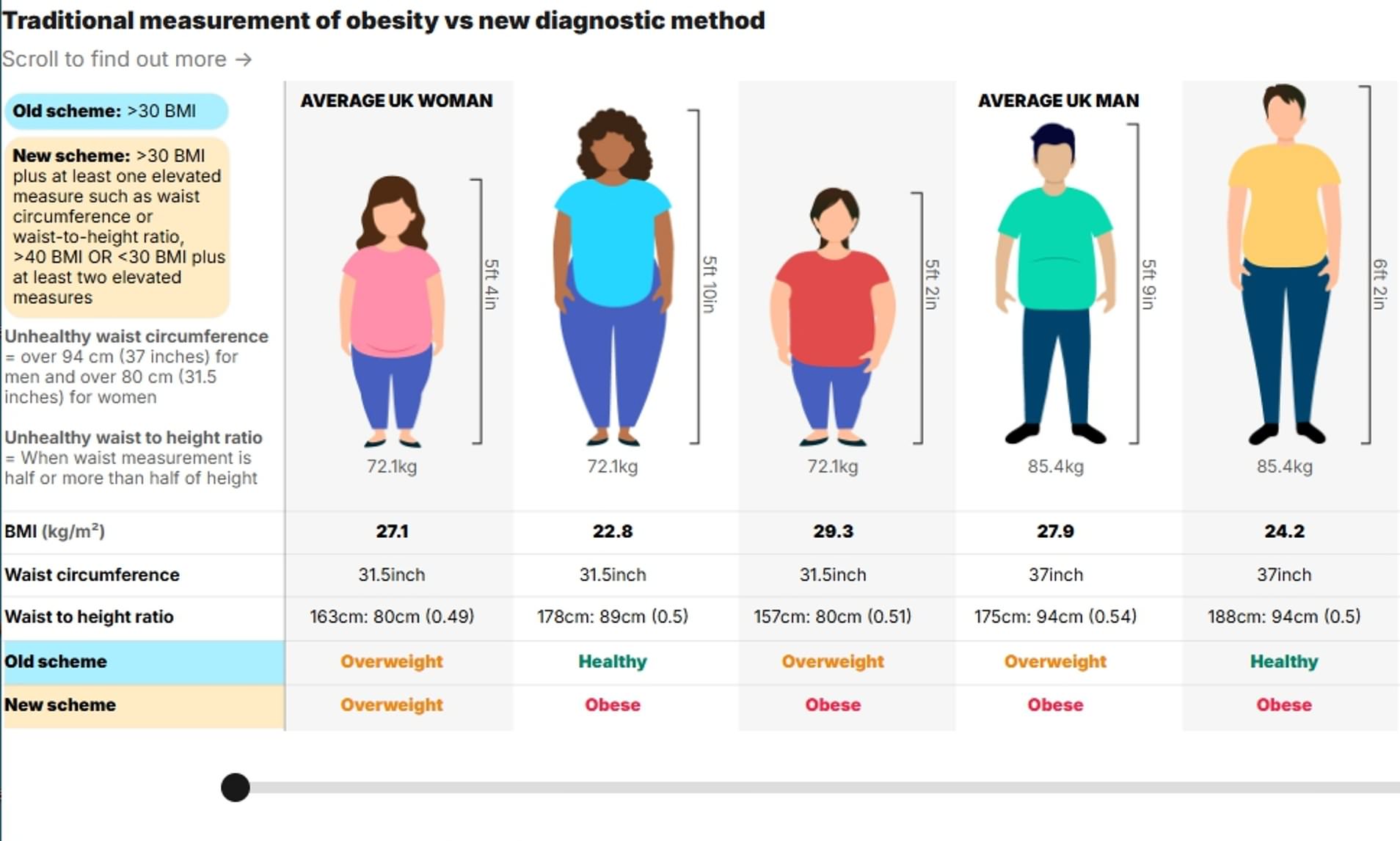
It has been discovered by scientists that millions of Britons, who have been informed they are in good health, might actually be obese.
According to the existing guidelines, a body-mass-index (BMI) ranging from 18.5 to 25 is considered healthy, between 25 and 29 is classified as overweight, and 30 or higher is categorized as obese — the threshold where the likelihood of severe health issues significantly increases.
However, obesity specialists have suggested a 'drastic transformation' in the way it is identified, contending that BMI charts by themselves are not 'sufficiently detailed'.
A surprising study released yesterday revealed that implementing the new definition would increase the number of individuals categorized as obese by nearly 60 percent.
Excess fat, according to researchers, can accumulate in individuals who are not usually classified as overweight or obese by existing standards, and it tends to gather around the midsection.
As people age, their bodies tend to accumulate more fat around the waist, and when this is paired with a loss of muscle mass, the total weight remains relatively stable.
This indicates that even with accumulating excess fat — a condition some refer to as 'skinny fat' — the BMI system does not trigger a warning, according to the researchers.
Many individuals are unaware that they are vulnerable to health issues associated with obesity, such as 'organ dysfunction'.
Rather, they recommend including waist size and weight-to-height ratio to aid in diagnosing obesity, providing a more comprehensive view of health — and many individuals could, in theory, be obese without being aware of it.
According to the updated guidelines, obesity would be classified as a BMI of 40 or higher, or a BMI exceeding 30 combined with at least one elevated indicator, like a higher waist size or a greater waist-to-height ratio.
Individuals might also be classified as obese according to the updated guidelines if their BMI is under 30 but they have two or more elevated measurements.
As per the NHS, a waist size of 37 inches (94 cm) or more is considered unhealthy for men, while for women, it is 31.5 inches (80 cm) or higher.
A high waist-to-height ratio is considered unhealthy when an individual's waist size is equal to or greater than half of their height.
For instance, the typical British man, who is 5 feet 9 inches tall and weighs 85.4 kilograms, would be classified as obese according to the updated criteria if his waist size measured 37 inches.
This is due to his waist-to-height ratio being 94cm:175cm, resulting in a score of 0.54.
Although his BMI was 27.9, which classified him as overweight according to the previous standards, he would have two elevated measurements.
A woman who is 5 feet 2 inches tall and weighs the typical UK female weight of 72.1kg would also be considered obese under the new guidelines and overweight according to the previous standards.
This is due to an unhealthy waist size of 31.5 inches, resulting in a waist-to-height ratio of 0.51, which means she has two elevated measurements.
In the UK, approximately 13 million adults are currently classified as obese. The latest estimate suggests this number could rise to almost 21 million.
Scientists supported their conclusions with a research project involving more than 300,000 U.S. adults aged 38 to 65, with approximately half being men and the other half women.
Writing in JAMA Network Open, the researchers from Harvard and Massachusetts General Hospital stated: 'The rate of obesity rose by 60 percent when applying the new definition instead of the traditional BMI-based approach.'
The updated definition of obesity was initially introduced in January through a report authored by 58 international specialists, featured in the renowned Lancet.Diabetes & Endocrinology journal.
At that time, their suggestions were supported by many groups, including the Royal College of Physicians.
Health professionals have often questioned the effectiveness of BMI as an indicator of well-being.
Created by a Belgian mathematician in the 1830s, medical professionals have used BMI for nearly two centuries.
A series of highly anticipated anti-obesity initiatives began to take effect in England at the start of this month.
New government regulations in England have banned "buy one, get one free" offers on candies, chips, sugary beverages, and other snacks, as well as complimentary refills of carbonated drinks in dining establishments and cafes.
The enforcement will be followed in January with a prohibition on online advertisements for unhealthy food and beverages, along with limitations on television advertising before 9 p.m.
Officials state that the measures aim to address the increasing issue of obesity in Britain.
A sobering study from last year highlighted that the growing obesity issue in Britain has led to a 39 percent increase in type 2 diabetes cases among individuals under 40, with approximately 168,000 young adults currently affected by the condition.
Being overweight has also been associated with at least 13 forms of cancer and is the second-largest avoidable factor contributing to the illness in the UK, as reported by Cancer Research UK.
Read more- Why are specialists in obesity advocating for a 'significant transformation' of BMI-related diagnoses affecting millions of people in Britain?
- Is obesity emerging as one of the major health dangers in Britain, with almost a quarter of adults experiencing severe weight-related health issues?
- If research indicates that millions could be considered obese with the new criteria, is altering your lifestyle the only option to combat an increasing BMI?
- Could a groundbreaking BMI update reshape the definition of obesity for millions, causing UK obesity rates to jump by 60% instantly?
- What impact is England's growing obesity problem having on reducing the lifespan of many citizens?